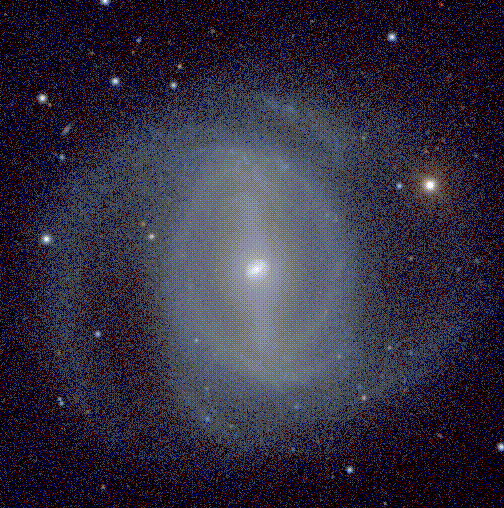Bar and ring structure in NGC 1433
 The stars orbiting in the disks of spiral galaxies can, under the
right conditions, exhibit a wealth of patterns caused by the
complex orbital mechanics of a widespread mass distribution, and
these patterns can in fact be used to diagnose internal motions.
NGC 1433 shows a wide range of these phenomena. A small elliptical
ring occurs close to the nucleus; this ring is a site of star
formation, and hence appears blue. This ring really is elliptical
rather than a circle, since the outer parts of the galaxy are nearly
round as we see them. Next outward is a bar, with delicate dust lanes
along one edge. The theory of stellar orbits in fact predicts that
bars and rings should either align parallel or perpendicular to one
another depending on the relative speeds ofindividual stars and the overall
pattern. There is a prominent outer ring, beyond which are two prominent
spiral arms. Between the two outer arms are shorter spur arms,
which may be locked in place by the gravitational disturbance produced
by the overall two-sided pattern.
This true-color composite was produced from CCD images taken by
Deborah Crocker and Lauren Jones (University of Alabama) at the
1.5-meter telescope of Cerro Tololo Inter-American Observatory, Chile.
The stars orbiting in the disks of spiral galaxies can, under the
right conditions, exhibit a wealth of patterns caused by the
complex orbital mechanics of a widespread mass distribution, and
these patterns can in fact be used to diagnose internal motions.
NGC 1433 shows a wide range of these phenomena. A small elliptical
ring occurs close to the nucleus; this ring is a site of star
formation, and hence appears blue. This ring really is elliptical
rather than a circle, since the outer parts of the galaxy are nearly
round as we see them. Next outward is a bar, with delicate dust lanes
along one edge. The theory of stellar orbits in fact predicts that
bars and rings should either align parallel or perpendicular to one
another depending on the relative speeds ofindividual stars and the overall
pattern. There is a prominent outer ring, beyond which are two prominent
spiral arms. Between the two outer arms are shorter spur arms,
which may be locked in place by the gravitational disturbance produced
by the overall two-sided pattern.
This true-color composite was produced from CCD images taken by
Deborah Crocker and Lauren Jones (University of Alabama) at the
1.5-meter telescope of Cerro Tololo Inter-American Observatory, Chile.
 UA Astronomy Home Page
UA Astronomy Home Page
 The stars orbiting in the disks of spiral galaxies can, under the
right conditions, exhibit a wealth of patterns caused by the
complex orbital mechanics of a widespread mass distribution, and
these patterns can in fact be used to diagnose internal motions.
NGC 1433 shows a wide range of these phenomena. A small elliptical
ring occurs close to the nucleus; this ring is a site of star
formation, and hence appears blue. This ring really is elliptical
rather than a circle, since the outer parts of the galaxy are nearly
round as we see them. Next outward is a bar, with delicate dust lanes
along one edge. The theory of stellar orbits in fact predicts that
bars and rings should either align parallel or perpendicular to one
another depending on the relative speeds ofindividual stars and the overall
pattern. There is a prominent outer ring, beyond which are two prominent
spiral arms. Between the two outer arms are shorter spur arms,
which may be locked in place by the gravitational disturbance produced
by the overall two-sided pattern.
This true-color composite was produced from CCD images taken by
Deborah Crocker and Lauren Jones (University of Alabama) at the
1.5-meter telescope of Cerro Tololo Inter-American Observatory, Chile.
The stars orbiting in the disks of spiral galaxies can, under the
right conditions, exhibit a wealth of patterns caused by the
complex orbital mechanics of a widespread mass distribution, and
these patterns can in fact be used to diagnose internal motions.
NGC 1433 shows a wide range of these phenomena. A small elliptical
ring occurs close to the nucleus; this ring is a site of star
formation, and hence appears blue. This ring really is elliptical
rather than a circle, since the outer parts of the galaxy are nearly
round as we see them. Next outward is a bar, with delicate dust lanes
along one edge. The theory of stellar orbits in fact predicts that
bars and rings should either align parallel or perpendicular to one
another depending on the relative speeds ofindividual stars and the overall
pattern. There is a prominent outer ring, beyond which are two prominent
spiral arms. Between the two outer arms are shorter spur arms,
which may be locked in place by the gravitational disturbance produced
by the overall two-sided pattern.
This true-color composite was produced from CCD images taken by
Deborah Crocker and Lauren Jones (University of Alabama) at the
1.5-meter telescope of Cerro Tololo Inter-American Observatory, Chile.
 UA Astronomy Home Page
UA Astronomy Home Page